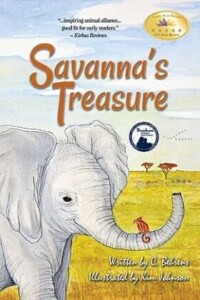Title: Savanna’s Treasure
Author: C. Behrens
Publisher: Jera Publishing
ISBN: 2nd Edition Coming Soon!
Pages: 132
Genre: Juvenile Fiction, Early Reader
Reviewed by: Kimberlee Hicks
Buy on Amazon
Pacific Book Review
It is too often believed that Children’s Literature only appeals to children. While there are a number of books in this genre that truthfully would not hold an adult’s interest for long, others satisfy by delving a little deeper into subjects that people of all ages can relate to and find exciting, and that also spark discussions between parent and child. In C. Behrens’ Savanna’s Treasure readers will find a story that is not only adventurous and heart-warming, but educational, as well.
One of the most important components in a good children’s book is an adventure, and Savanna’s Treasure is a non-stop rollercoaster of excitement. The story’s protagonists – Shamba, the field mouse, and Kali, the baby elephant – face challenges they strive to overcome, from the very first page, to the very last. Beset by numerous hardships, the two form an unusual friendship in their struggle to survive. The personalities of the two characters are distinctive; Shamba always remains hopeful, refusing to give up, while Kali does not adjust as well, needing the occasional coaxing from her friend. Their individuality is refreshing, avoiding the sadly common pitfall of one-dimensional characters in Children’s Literature, who lack any depth or color.
Savanna’s Treasure includes a smattering of illustrations. It seems a crime to call them ‘simple’, though they are by no means dramatic, and not even colored. However, they are beautiful, and the detail practically beyond description. Every hair on a cheetah is perfectly in place, each field mouse has his stripes and claws. Every fold of every elephant’s skin imbues so much life into what is, again, a ‘simple’ illustration. You easily wish there were more, and will eagerly look at the artwork as much as read the book.
What elevates this book is its educational value. The author wrote with an eye toward teaching his readers something about the savanna while they read it. The reader learns about animal behavior, particularly that of elephant herds. More than that, Behrens writes about poachers, and their horrific, illegal, activity. It’s a lesson children will remember, and can discuss with their parents, learning more about endangered wildlife. Children will also be introduced to places like the elephant orphanage, and about how greatly over-taxed they are.
Not every detail herein is entirely accurate, as artistic license has been taken for entertainment value – cheetahs will eat mice, not befriend them, of course – however, reading Savanna’s Treasure is an excellent opportunity for children to learn while they’re young, and be inspired to find out more on their own.
For any child making their first foray into reading chapter books, this is a good place to start. Parents can enjoy it along with them, and it may even inspire discussions about real world situations, or at least an interest in the animal kingdom. At the very least, it’s a story about perseverance, friendship, and not judging books by their cover. All lessons our children should be learning as early as possible.



Follow Us